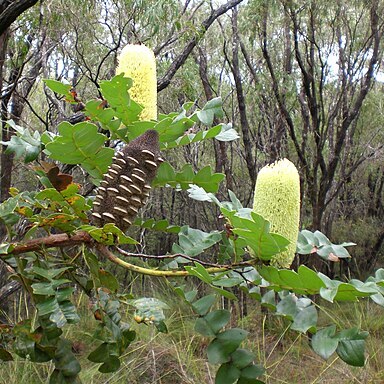Tree to 10 m, in coastal areas sometimes a shrub, fire tolerant. Bark thick, rugose. Stems stout, tomentose, glabrescent. Leaves: petiole 10-35 mm long; lamina pinnatisect with 8-12 large, triangular lobes each side, obovate-cuneate, 10-45 cm long, 3-11 cm wide, truncate; margins recurved; upper surface tomentose, glabrescent; lower surface tomentose, glabrescent except fine wool in pits. Inflorescence 10-40 cm long, 7-9 cm wide at flowering; involucral bracts to 25 mm long, tomentose, falling after flowering. Flowers pale yellow; upper flowers often with turquoise or grey tinge; styles cream. Perianth 26-35 mm long including limb of 4-5 mm, hirsute both sides with glabrous limb. Pistil 35-40 mm long, glabrous; pollen presenter slightly thickened, 1-1.5 mm long. Old flowers soon falling. Follicles many in a massive cone, elliptic, 17-25 mm long, 3-10 mm high, 6-12 mm wide; valves smooth but groove wrinkled, tomentose. Seed obovate-cuneate, 32-38 mm long; seed body obovate, 12-16 mm long, 7-9 mm wide, smooth inside, somewhat rugose outside.
More
A tree. It grows up to 5-10 m high and spreads 3-8 m wide. The leaves are large. They can be 50 cm long. They are held in clumps. They have triangular lobes arranged along a central spine. It has large flower spikes. They are pale yellow and 40 cm long.


